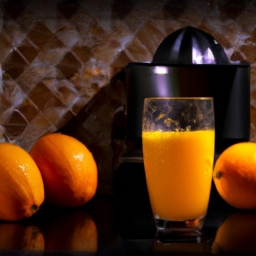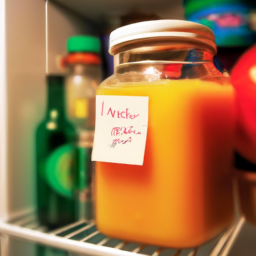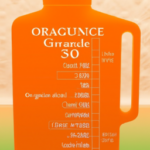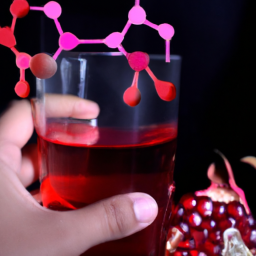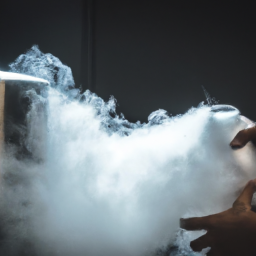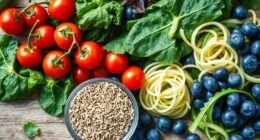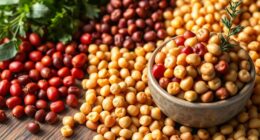I understand your thoughts: ‘Freshly squeezed orange juice tastes amazing, but what’s its real shelf life?’
It’s a valid concern, as nobody wants to drink spoiled juice and risk getting sick. The shelf life of fresh squeezed orange juice is influenced by several factors, including storage and the condition of the oranges used.
In this article, I’ll be discussing these factors and providing tips on how to extend the shelf life of your freshly squeezed juice.
First, it’s important to understand that fresh squeezed orange juice doesn’t last as long as store-bought varieties. This is because it lacks preservatives and has a shorter shelf life due to its natural ingredients.
However, the quality of fresh squeezed orange juice is unparalleled, and it’s worth the extra effort to enjoy it. With proper storage techniques and a few tricks, you can enjoy your fresh squeezed orange juice for several days.
So let’s dive in and explore how to make the most of your juice!
Key Takeaways
- Fresh squeezed orange juice has a shorter shelf life than store-bought due to lack of preservatives.
- Proper storage techniques include airtight containers, cool temperature (40°F or below), and avoiding exposure to air and light.
- Natural additives like lemon juice and honey can extend shelf life while maintaining taste and nutrition.
- Freezing in ice cube trays and blending with other juices can extend shelf life for up to 6 months.
Factors Affecting the Shelf Life of Fresh Squeezed Orange Juice
Don’t waste your money on fresh squeezed orange juice if you don’t know the factors that affect its shelf life.
One of the most crucial factors is the juice extraction method. Orange juice extracted using a hydraulic press or a hand juicer has a shorter shelf life compared to that extracted using a centrifugal juicer. This is because the former methods introduce more oxygen into the juice, which hastens the oxidation process. Juice extracted using a centrifugal juicer, on the other hand, is exposed to less oxygen and has a longer shelf life.
Another factor that affects the shelf life of fresh squeezed orange juice is the impact of additives. Some additives, such as preservatives, can extend the juice’s shelf life. However, they may also alter the taste and nutritional value of the juice. Natural additives, such as lemon juice and honey, can also extend the shelf life of orange juice while maintaining its taste and nutritional value.
Proper storage is also crucial in extending the shelf life of fresh squeezed orange juice.
The Importance of Proper Storage
When it comes to storing fresh squeezed orange juice, there are a few key points to keep in mind.
First, temperature is crucial; it should be stored at 40°F or below to slow down the growth of microorganisms.
Second, the container used for storage should be airtight to prevent exposure to air and light, both of which can cause the juice to spoil more quickly.
Lastly, it’s important to avoid exposure to air and light by storing the juice in a cool, dark place.
By following these guidelines, you can ensure that your fresh squeezed orange juice lasts as long as possible.
Temperature Requirements
To keep fresh squeezed orange juice at its best, it’s important to store it in the refrigerator at a temperature between 32°F and 40°F. Optimal storage temperature is crucial in extending the shelf life of orange juice.
Here are some facts to keep in mind:
- High temperatures can cause the growth of bacteria and spoil the juice faster.
- Slightly warmer temperatures can speed up the oxidation process, leading to a shorter shelf life.
- Cold temperatures can cause the juice to freeze, which can alter the taste and texture of the juice.
Avoid storing orange juice in the fridge door because it’s subject to temperature fluctuations every time the door is opened and closed.
Proper temperature is just one aspect of ideal storage for fresh squeezed orange juice. Another aspect is the type of storage container used.
Let’s take a look at the next step to keeping your juice fresh.
Storage Containers
Choosing the right storage container for your fresh orange juice can make a big difference in how well it maintains its flavor and quality. There are various types of containers available in the market, each with its own set of pros and cons. It is important to consider the material, size, and sealability of the container before making a choice.
Glass and plastic containers are the most popular choices for storing fresh orange juice. Glass containers are non-reactive and do not leach any chemicals into the juice, maintaining its purity. However, glass containers are fragile and can break easily. Plastic containers, on the other hand, are shatterproof and lightweight, making them an ideal choice for transportation. However, plastic containers can leach chemicals into the juice over time. When storing fresh orange juice, it is best to use a container with an airtight lid to prevent oxidation and spoilage.
To ensure the longevity of your fresh squeezed orange juice, it is crucial to follow the best storage practices. Refer to the table below for a quick guide on the various types of containers and their advantages and disadvantages. In the next section, we will discuss how to avoid exposure to light and air, which can have a significant impact on the shelf life of your fresh orange juice.
| Container Type | Advantages | Disadvantages |
|---|---|---|
| Glass | Non-reactive, maintains purity | Fragile, can break easily |
| Plastic | Shatterproof, lightweight | Can leach chemicals into juice |
| Stainless Steel | Durable, easy to clean | Expensive, not see-through |
Avoiding Exposure to Light and Air
One key factor in maintaining the quality of your OJ is keeping it away from light and air. This is because both light and air can significantly reduce the nutrient content and freshness of your juice. Here are some tips for juicing efficiently and preserving nutrients:
- Store your freshly squeezed orange juice in a dark and airtight container to protect it from light and air exposure.
- Use a citrus juicer to extract the juice from oranges instead of a blender or food processor, which can damage the delicate nutrients in the juice.
- Drink your orange juice as soon as possible after juicing to enjoy its maximum nutritional benefits.
By following these tips, you can ensure that your orange juice stays fresh and nutrient-rich for longer.
In the next section, we’ll discuss how to tell if fresh squeezed orange juice has gone bad.
How to Tell If Fresh Squeezed Orange Juice Has Gone Bad
You can easily tell if your fresh squeezed orange juice has gone bad by checking for a sour or off smell, and a cloudy or discolored appearance. These are clear signs of spoilage that can occur due to common contaminants like bacteria, yeast, or mold.
It’s important to note that even if the juice looks and smells fine, it may still be unsafe to consume if it’s been sitting out for too long. To avoid the risk of consuming bad orange juice, it’s best to consume it within the first 24 hours of squeezing. If you need to store it for a longer period, consider refrigerating it in an airtight container.
In the next section, we’ll discuss some tips for extending the shelf life of fresh squeezed orange juice.
Tips for Extending the Shelf Life of Fresh Squeezed Orange Juice
As someone who enjoys fresh squeezed orange juice, I’ve found that extending its shelf life can be a challenge.
One solution is to add preservatives to the juice, such as ascorbic acid or citric acid, which can help prevent spoilage.
Another option is to freeze the juice in ice cube trays and store them in an airtight container in the freezer for up to six months.
Lastly, blending fresh squeezed orange juice with other ingredients, such as apple or carrot juice, can create new flavors while also increasing its shelf life.
Adding Preservatives
By adding preservatives, the shelf life of fresh squeezed orange juice can be extended, but as the adage goes, "everything comes at a cost."
Alternative preservatives such as sodium benzoate, potassium sorbate, and calcium propionate are some of the commonly used food preservatives that can be added to fresh squeezed orange juice. These preservatives work by inhibiting the growth of bacteria, yeasts, and molds that cause food spoilage. However, some studies suggest that excessive consumption of these preservatives may cause adverse health effects.
Alternatively, natural preservation methods can also be used to extend the shelf life of fresh squeezed orange juice without the need for chemical preservatives. These methods include pasteurization, high-pressure processing, and ultrafiltration.
Pasteurization involves heating the juice at a high temperature for a short period of time to kill bacteria and enzymes that cause spoilage. High-pressure processing and ultrafiltration, on the other hand, involve subjecting the juice to high pressure or filtering it through a membrane to remove microorganisms.
With these methods, the nutrition and flavor of the juice can be preserved, but they can be more expensive than using chemical preservatives. When it comes to preserving fresh squeezed orange juice, freezing is also an option that can be explored.
Freezing Fresh Squeezed Orange Juice
Freezing fresh squeezed orange juice is an effective method for preserving the flavor and nutrients of the juice without the need for additional preservatives. Whether you have an abundance of juice or want to stock up for later use, freezing is a great option that allows you to enjoy the freshness of the juice for a longer period of time.
Here are some creative recipes and unique storage methods to help you make the most out of frozen orange juice:
- Freeze orange juice in ice cube trays and use them to add flavor to smoothies or cocktails.
- Store frozen orange juice in airtight containers to prevent freezer burn and preserve the taste.
- Mix frozen orange juice with other frozen fruits to create a delicious and healthy sorbet.
- Use frozen orange juice in marinades for meat or fish dishes to add a tangy flavor.
By freezing fresh squeezed orange juice, you can avoid the use of preservatives while still maintaining its taste and nutritional value. Now that you know how to freeze orange juice, let’s move on to the next section about blending with other ingredients to create even more delicious drinks and dishes.
Blending with Other Ingredients
Blending frozen orange juice with complementary ingredients can result in a plethora of delectable drinks and dishes. When it comes to blending techniques, there are several options to choose from. One popular method is to blend frozen orange juice with other frozen fruits like strawberries, mangoes, and pineapples to create a refreshing smoothie. Another approach is to blend orange juice with yogurt, honey, and ice to make a creamy and sweet drink. For those who prefer a savory twist, blending orange juice with herbs like basil and ginger can add a unique and flavorful kick to any dish.
When it comes to flavor combinations, the possibilities are endless. The table below showcases some popular combinations that can take your orange juice blending game to the next level. Whether you’re looking for a sweet, tangy, or spicy drink, there’s a flavor combination that will suit your taste buds.
| Complementary Ingredient | Flavor Profile | Recipe Suggestions |
|---|---|---|
| Strawberries | Sweet | Strawberry-Orange Smoothie |
| Pineapple | Tropical | Pineapple-Orange Margarita |
| Yogurt | Creamy | Orange Creamsicle Smoothie |
| Ginger | Spicy | Ginger-Orange Immunity Shot |
Understanding the nutritional value of fresh squeezed orange juice is important to ensure that you’re getting all the vitamins and minerals your body needs.
Understanding the Nutritional Value of Fresh Squeezed Orange Juice
You’ll love the burst of vitamin C and other essential nutrients found in fresh squeezed orange juice, making it a healthy and delicious addition to your daily routine.
Juice extraction plays a crucial role in retaining the nutritional value of the juice. The process involves separating the pulp and fiber from the liquid, which results in a high concentration of vitamins, minerals, and antioxidants.
When you drink fresh squeezed orange juice, you’re providing your body with essential nutrients that can help boost your immune system, promote healthy digestion, and improve your skin health.
Additionally, the high levels of vitamin C found in orange juice can help reduce the risk of chronic diseases such as heart disease and cancer.
With all these health benefits, it’s no wonder that fresh squeezed orange juice is a popular choice among health conscious individuals.
Health Benefits of Drinking Fresh Squeezed Orange Juice
After understanding the nutritional value of fresh squeezed orange juice, it’s time to delve into the health benefits that come with drinking this delicious beverage. Not only does it taste great, but it also provides numerous benefits for our body. As someone who cares about their health, drinking fresh squeezed orange juice is a great way to boost your immune system, promote healthy skin, and aid digestion.
To illustrate the many health benefits of fresh squeezed orange juice, refer to the following table:
| Benefits of Fresh Squeezed Orange Juice | Other Fruit Juices |
|---|---|
| High in Vitamin C | May contain added sugars |
| Promotes healthy skin | May be high in calories |
| Boosts immune system | May not contain as many nutrients |
| Aids digestion | May contain artificial flavors and colors |
As you can see, fresh squeezed orange juice is a great option for those looking to improve their health. Unlike other fruit juices, it contains a high amount of vitamin C and has no added sugars or artificial flavors. Additionally, it promotes healthy skin, boosts our immune system, and aids in digestion. Incorporating fresh squeezed orange juice into your daily diet is an easy and delicious way to reap these benefits.
To learn how to make fresh squeezed orange juice at home, continue reading the next section.
How to Make Fresh Squeezed Orange Juice at Home
I love making fresh squeezed orange juice at home!
To get the best results, I always make sure to choose the right kind of oranges – Valencia oranges are my personal favorite for their juiciness and sweetness.
When it comes to preparation and juicing, I wash the oranges thoroughly and then use a handheld juicer to extract the juice.
Finally, I store the juice in an airtight container in the refrigerator and serve it chilled for maximum freshness.
Choosing the Right Oranges
Although some may think that any type of orange can be used for fresh squeezed juice, it’s important to choose oranges that are juicy and sweet, like Valencia oranges.
When selecting ripe oranges, look for ones that are heavy for their size, have a smooth texture, and are free of blemishes or soft spots.
Additionally, the sweetness and juiciness of the oranges can be enhanced by selecting organic oranges, which are grown without the use of harmful pesticides or chemicals.
It’s important to properly prepare and juice the oranges to ensure the best taste and longevity of the juice.
To prepare the oranges, wash them thoroughly with water and dry them with a towel.
Cut them in half and use a manual or electric juicer to extract the juice.
By using fresh, ripe, and organic oranges and properly juicing them, you can enjoy delicious and long-lasting fresh squeezed orange juice.
Preparation and Juicing
Now that we’ve covered how to choose the right oranges for fresh squeezed orange juice, let’s move on to the preparation and juicing process. It’s important to note that there are various juicing techniques and equipment available, but selecting the right ones can make a significant difference in the quality and shelf life of your juice.
One of the most popular juicing techniques is using a citrus juicer. This type of equipment is specifically designed to extract juice from citrus fruits, making the process more efficient and producing a higher yield. Another option is using a blender or food processor, which can also be effective but may require straining the juice to remove any pulp or seeds. Whichever technique you choose, it’s important to ensure that your equipment is clean and sanitized before use to prevent any contamination. By using the right juicing techniques and equipment, you’ll be able to produce a delicious and fresh batch of orange juice that will last longer and taste better.
| Juicing Technique | Pros | Cons | Best For |
|---|---|---|---|
| Citrus Juicer | Efficient, higher yield | Expensive, limited to citrus fruits | Frequent juicers, large batches |
| Blender/Food Processor | Versatile, can handle other fruits and vegetables | May require straining, lower yield | Small batches, occasional juicers |
Moving on to the next step, let’s talk about the storage and serving of fresh squeezed orange juice.
Storage and Serving
To ensure that your delicious juice stays at its peak quality, you’ll want to know the best ways to store and serve it. Here are some tips that will help you get the most out of your fresh squeezed orange juice:
-
Store in an airtight container: Oxygen exposure can quickly deteriorate the flavor and nutritional value of your juice. To prevent this, you should store your juice in an airtight container in the refrigerator. This will help preserve the freshness of your juice for up to 3 days.
-
Freeze for later use: If you want to keep your juice for longer, you can freeze it. Pour the juice into ice cube trays and freeze for a few hours. Once frozen, transfer the cubes to a zip-lock bag and store in the freezer. Your juice will last for up to 6 months in the freezer.
-
Serve with creative ideas: To make your fresh squeezed orange juice more interesting, you can serve it in different ways. For example, you can add a splash of sparkling water for a fizzy taste, or mix it with other fruits to make a delicious smoothie.
Now that you know how to store and serve your fresh squeezed orange juice, let’s move on to comparing it with store-bought varieties.
Comparing Fresh Squeezed Orange Juice to Store-Bought Varieties
You can taste the difference between fresh squeezed orange juice and store-bought varieties, and it’s not just your imagination. Juice quality and taste comparison studies have consistently shown that fresh squeezed orange juice is superior in taste and nutritional value.
A study conducted by the University of California, Davis found that fresh squeezed orange juice has up to 50% more vitamin C than store-bought options. Other studies have shown that fresh squeezed orange juice has higher levels of antioxidants, flavonoids, and other beneficial nutrients.
The reason for this difference in quality comes down to processing. Store-bought orange juice is often made from concentrate, which involves removing the water from the freshly squeezed juice and then reconstituting it later. This process can strip the juice of its natural flavor and nutrients, resulting in a less flavorful and less nutritious final product.
In contrast, fresh squeezed orange juice is made by simply pressing the juice out of the oranges and then drinking it immediately. This ensures that the juice retains all of its natural flavor and nutrients. As a result, fresh squeezed orange juice is not only tastier, but also healthier.
Fresh squeezed orange juice is not only great for drinking, but it also has a variety of other uses. From marinades to salad dressings, fresh squeezed orange juice can add a delicious and nutritious burst of flavor to any dish.
In the next section, we’ll explore some of the creative ways that you can use fresh squeezed orange juice to enhance your cooking.
Other Uses for Fresh Squeezed Orange Juice
I’m excited to share some other uses for fresh squeezed orange juice beyond just drinking it.
One great application is in cooking and baking, where the juice can add a bright, citrusy flavor to dishes like marinades, dressings, and desserts.
Additionally, the acidity in orange juice makes it a great natural cleaner for household applications, such as removing stains or freshening up surfaces.
Cooking and Baking
Cooking and baking with fresh squeezed orange juice adds a burst of citrus flavor to any recipe. When cooking with oranges, it’s important to use ripe ones to get the best flavor. The juice can be used in marinades, salad dressings, sauces, and even desserts.
One of my favorite recipes to make with fresh squeezed orange juice is orange chicken. I marinate the chicken in a mixture of orange juice, soy sauce, garlic, and ginger, then bake it until it’s crispy. The result is a sweet and tangy dish that’s perfect for a weeknight dinner.
Fresh squeezed orange juice can also be used to make a variety of orange juice cocktails. One popular drink is the mimosa, which is a combination of orange juice and champagne. Another delicious cocktail is the Aperol Spritz, made with Aperol, Prosecco, and fresh squeezed orange juice. When using fresh squeezed orange juice in cocktails, it’s important to strain the pulp to get a smooth consistency.
Using fresh squeezed orange juice in cooking and cocktails is a great way to add flavor to your dishes. However, it’s not just limited to the kitchen. There are many other household applications for orange juice, including cleaning and stain removal.
Cleaning and Household Applications
When it comes to household cleaning, using orange peels to make a DIY cleaner may seem like an extra step, but the natural oils in the peels add a powerful cleaning element that you may not expect.
Here are three ways to use orange peels for household cleaning:
-
Make a citrus-infused all-purpose cleaner by filling a jar with orange peels and white vinegar. Let the mixture sit for a week before straining out the peels and diluting the solution with water.
-
Use orange peels to clean stainless steel appliances by rubbing the peel directly on the surface. The oils in the peel will help remove dirt and grime while leaving a fresh citrus scent.
-
Create a natural air freshener by simmering orange peels in a pot of water on the stove. Not only will this freshen up your home, but it also helps humidify the air during the dry winter months.
In addition to household cleaning, orange peels can also be used in DIY beauty products. The natural oils in the peels are great for adding moisture and brightening skin.
Try mixing finely grated orange peel with honey and plain yogurt for a refreshing face mask. The antioxidants in the orange peel will help fight free radicals and leave your skin looking radiant.
Frequently Asked Questions
Can you freeze fresh squeezed orange juice?
Yes, fresh squeezed orange juice can be frozen for long-term storage. To preserve flavor, it’s recommended to store it in airtight containers or freezer bags. Thaw in the refrigerator before consuming.
How long does it take for fresh squeezed orange juice to spoil if left out at room temperature?
Leaving fresh squeezed orange juice at room temperature increases the risk of bacterial growth. Proper storing techniques, such as refrigeration, can slow this process. Time until spoilage varies, but it’s best to consume within 24 hours.
Is it safe to drink fresh squeezed orange juice past its expiration date?
It is not recommended to consume fresh squeezed orange juice past its expiration date, as the nutritional value may decrease and harmful bacteria can grow. Proper refrigeration and consumption within the recommended timeframe is crucial for optimal safety and quality.
Does adding sugar or other ingredients affect the shelf life of fresh squeezed orange juice?
Drinking fresh squeezed orange juice with added sugar is like sipping liquid sunshine. The effect of preservatives on shelf life can vary, but storing in the refrigerator and consuming within a few days is recommended.
Can you mix fresh squeezed orange juice with other types of fruit juice?
Yes, fresh squeezed orange juice can be mixed with other types of fruit juice to create delicious juice combinations with added nutritional benefits. However, it is important to consider the sugar content and acidity levels of the other fruits.
Conclusion
Well, there you have it folks – everything you need to know about fresh squeezed orange juice! From the factors affecting its shelf life, to the health benefits of drinking it, to the various ways you can enjoy it – we’ve covered it all.
But let me tell you, this juice isn’t just any ordinary beverage. It’s like a burst of sunshine in a glass, a refreshing and nutritious way to start your day. Trust me, once you try fresh squeezed orange juice, there’s no going back to the store-bought stuff.
So go ahead, grab some oranges, squeeze away, and enjoy the deliciousness that is fresh squeezed orange juice. And remember, with proper storage and handling, you can extend its shelf life and savor it for even longer.
Cheers to good health and good taste!
Ilana has been a vegan for over 10 years. She originally made the switch for health reasons, but soon found herself becoming more and more passionate about the ethical and environmental implications of a vegan lifestyle. Ilana is the author of The Graceful Kitchen, a blog all about veganism. She loves to cook up delicious and nutritious vegan meals, and share her recipes with others who are interested in leading a cruelty-free life. Ilana is also a strong advocate for using whole foods as the foundation of a healthy diet, and believes that going vegan is one of the best ways to achieve this.
